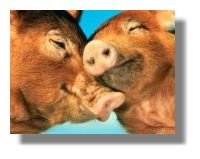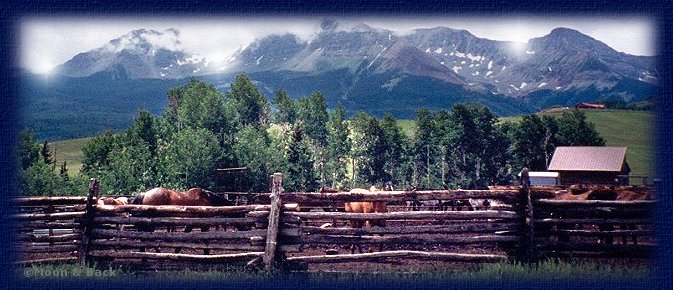
8E. Coli Scours & Clostridial Infection
Single pigs or whole litters may be affected.
Gilt litters are more often affected than sow
litters, which suggests that gilts lack specific
antibodies to pass on to their litters in colostrum.
Pigs 0-4 days of age are most commonly
diagnosed with E. coli scours and clostridial
infection. Common Names: Scours, neonatal
piglet diarrhea, enterotoxemia.
8 F.A.Q.
Q: Is it just one 10 cc dose for each calf?
A: Normally, yes. There are special circumstances that require a second, sometimes a third dose.
Q: Does size make any difference?
A: No, on young calves. Older calves, for stress, it's 5 cc's for every 100 lbs. i.e. before transportation.
Q: What form of payments do you take?
A: We take Master Card and Visa over the telephone. We also take Money Orders, and Cashier Checks by mail made out to: Larson Century Ranch.
Q: What are the product(s) ingredients?
A: The formulation for the LCR Paste Plus! is comprised of "All Natural Supplements". Sorry, specifics cannot be provided. We have signed a non-disclosure proprietary agreement with the lab.
Q: Do you doctor a calf at first signs?
A: Absolutely!!
Q: How do you ship?
A: We provide customer preference, including overnight delivery available. Call for shipping arrangements for your geographical area
Q: How much does LCR Paste Plus! cost?
A: Pricing:
- Paste: $100
- Applicator: $20
*Tube = 30 Treatments (No Shipping Charges)
Common Questions About Calf Scours
Q. What causes calf scours?
A. Calves are usually affected first by some kind of outside influence -- cold or wet weather, difficult birth, poor sanitation or a cow that is in poor health or is just a poor mother. Those factors lower the calf's resistance to disease and set the calf up for infectious causes -- bacteria and viruses that invade the gut, causing severe diarrhea and loss of essential body fluids and electrolytes. Bacteria are a common cause of scours.
E. coli is the most common and is usually seen in scours cases occurring in the first seven (7) days after birth. One of the most deadly causes of scours is another type of bacteria, Clostridium perfringens type C, which causes enterotoxemia or sudden death. Salmonella is found in some cases. Viruses such as rotavirus and coronavirus also play a role. Viral scours are often seen 7 to 21 days after birth, but can occur anytime in the first 4 weeks. Parasites such as cryptosporidia can also cause scours.
For more information relative to the above (See: Cause & Prevention)
Q. How can I prevent calf scours?
A. You need to deal with both management and infectious causes. Here are 7 tips for better management:
- Keep cows healthy and nutritionally sound.
- Deworm cows to optimize health.
- Help with calving, if needed.
- Keep a clean area just for calving.
- Practice good sanitation (wash hands, equipment, boots).
- Make sure calves get plenty of colostrum (1-2 quarts) and that they get it quickly (within 4 hours
after birth, if possible).
- Move healthy pairs to clean, open pastures.
Q. What are the symptoms of calf scours?
A. The most obvious sign of scours is profuse diarrhea, which is often yellow, white or green, and can be very watery or in some cases bloody. Diarrhea causes the calf to lose fluid, which results in depression, sunken eyes, dry skin and eventually an inability to stand or to nurse. If not treated quickly and correctly, calves go into shock and coma and eventually die.
Q. How do I treat scouring calves?
A. Death loss from calf scours is the result of rapid loss of body fluids and electrolytes, so the most important step is to quickly rehydrate scouring calves.
Q. Besides medical treatment, how should scouring calves be handled?
A. Again, good management is the key. Here are 5 suggestions:
- Isolate scouring calves and their mothers from healthy ones.
- Keep calving area clean and dry.
- Keep equipment clean; be sure workers wash hands and boots thoroughly after treating sick calves and before working with healthy calves.
- Move healthy pairs to clean, open pasture
- Separate first-calf heifers from mature cows both pre- and post-calving.
Q. Should we send anything in to the lab?
A. We recommend diagnosing scours so that we can understand exactly what is causing the outbreak. This helps treat new cases and prevent future outbreaks. Please consult the clinic first -- if samples are submitted, follow these guidelines:
- Collect and submit feces within 12 hours of onset of diarrhea.
- Submit dead calves for posting as soon as possible.
- In severe cases, submitting a live, scouring calf may be in order
Q. Wouldn't it be less expensive just to treat the few scours cases we may get, rather than treating all calves in the herd?
A. Compare the cost of a vaccination program with the value of your calves -- especially in today's strong market. Death loss of 35-50 per cent in unprotected calves is not unusual when a scours outbreak hits your herd. Calves that do survive rarely perform to their full potential, with reduced weaning weights being the costliest result. Often, the cost of losing even one calf will cover what you would have spent protecting all the pregnant cows in the herd.

Click here to add text.

All Natural -- Use WITH or WITHOUT Antibotics. FREE Consultations !!
An All Natural Mineral Product
That Controls Scours!
This page was last updated on: 2/1/2010
P. O. Box 1982
Clarkston, WA 99403
Telephone: 509-758-5445
FAX: 509-758-5701
E-Mail: Sales@LarsonCenturyRanch.com
Web Designer: Design Carte


Larson Century Ranch, Inc.

[Top]


[Top]


